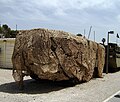Armoured personnel carrier
An armoured personnel carrier (APC) is an armoured fighting vehicle designed to transport infantry to the battlefield.
APCs are usually armed with only a machine gun although variants carry recoilless rifles, anti-tank guided missiles (ATGMs), or mortars. They are not usually designed to take part in a direct-fire battle, but to carry troops to the battlefield safe from shrapnel and ambush. They may have wheels or tracks.
Examples include the American M113 (tracked), the British FV 432 (tracked), the French VAB (wheeled), the Dutch/German GTK Boxer (wheeled) and the Soviet BTR (wheeled). Infantry fighting vehicles, by contrast, are more heavily armed and armoured and are designed for direct combat.
History


During World War I, when the tank was developed, the British Mark V* tank was designed with a small passenger compartment to carry troops. By some definitions this can be considered the first armoured personnel carrier. The first specialised APC was the Mark IX of 1918.
During World War II, half-tracks such as the American M3 and the German SdKfz 251 played a role similar to the armoured personnel carriers that were developed later on. Another forerunner to the APC during this time was the British Universal Carrier also known as the Bren Carrier for the weapon it was designed to carry. Often, APCs were simply armoured cars with the capacity for carrying troops, but they evolved into purpose-built vehicles to suit the demands of motorised warfare from World War II.
In 1944, the commander of II Canadian Corps, General Guy Simonds, ordered the conversion of 72 US-produced M7 Priest self-propelled howitzers to personnel carriers. They were, at the time, being replaced by the British Ordnance QF 25 pounder, and no future plans had been drawn up for them.
The howitzer was removed, and the resulting hole was plugged with whatever steel was available. The vehicle was called Kangaroo, after the codename of the workshop which did the conversion. Later in the war Canadian-built Ram tanks were used as a basis for the majority of conversions, as they were replaced by US Sherman tanks, and the original Kangaroos were converted back to self-propelled howitzers and returned to American forces.
After the war, different specialised APCs were developed. The United States developed a series of tracked vehicles, culminating in the M113 "box on tracks", of which 80,000 were made. The Soviet Union developed the Cold War BTR-40, BTR-152, BTR-60, BTR-70 and BTR-80 into a series of 8-wheeled APC.
Although the M113 was designed as an APC, it was among the first to be used in battle in the early 1960s when South Vietnam ARVN troops fought while mounted against infantry which sometimes lacked effective antitank weapons. After the Battle of Ap Bac showed that the exposed machine gun was vulnerable to enemy fire, they were fitted with the ACAV armour kit which protected the main machine gun and added shields for two additional gunners. The M113 served in Vietnam as one of the most effective and widely used armoured vehicles of that war, and remains in service today as a lighter and less expensive alternative to purpose-built IFVs.
The infantry fighting vehicle is a development of the armoured personnel carrier concept.
Design
Most armoured personnel carriers use a diesel engine comparable to that used in a large truck or in a typical city bus (APCs are often known to troops as 'Battle Taxis' or 'Battle Buses'). The M113 for instance used the same engine as the standard General Motors urban bus.
Many APCs are amphibious. Usually tracked APCs are powered by their tracks in the water, and wheeled APCs have propellors or water jets. Preparations for amphibious operations usually comprises checking the integrity of the hull and folding down a trim vane in front. Swimming required fairly still waters, and good entry and exit points. Speed in water is typically 3–6 km/h.
Armour on APCs are usually composed of simple steel or aluminium, sufficient for protection against small fire arms and most shell fragments. Just about any type of anti-tank weapon can defeat the armour of an APC. Some APC's also come with NBC protection, which would protect it's crew from radioactive fallout or the like.
The usual armament for an APC can vary from a 12.7 (.50") or 14.5 mm heavy machine gun to a 30 mm Automatic cannon. This is mounted on top of the vehicle, either on a simple pintle mount, sometimes with a gun shield, or a small turret. Sometimes an automatic grenade launcher is used instead. APCs such as the BTR-90 also have the capability to launch ATGM, which gives it a Anti-tank capability.
Gallery
-
SWAT Truck of Bryan, Texas
-
GTK Boxer German/Dutch APC (here: a German Army model)
-
A French VAB, one of the most common wheeled APCs
-
A New Zealand NZLAV III
-
A camouflaged Israeli APC.
-
Pindad Panser - ANOA 6X6 APS, Indonesia APC
-
Soviet personnel carrier based on a tank chassis.
-
The VBCI, armoured personnel carrier of the French Army.
See also
- Half-track
- Infantry fighting vehicle
- List of modern armoured fighting vehicles
- Armoured car (military)
- Tarmour










